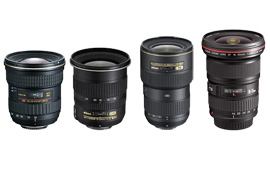These lenses are used to shoot landscapes, panoramic images, and architectural subjects (again, for this last, with resulting straight line deformation).
We tested a Tokina very wide-angle lens on Nikon and Canon mounts – the Tokina AT-X 12-24 AF PRO DX Nikon and the Tokina AT-X 12-24 AF PRO DX Canon.
Since their appearance in 2004, these lenses have been joined by some serious competitors: the Canon EF 16-35mm f/2.8L II USM (2007), the Sigma 12-24mm F4.5-5.6 EX DG HSM II Canon (2011), the Nikon AF-S Nikkor 16-35mm f/4G ED VR (2010), and the Sigma 12-24mm f4.5-5.6 EX DG Nikon (2003).
Let’s take a look at the results for the Tokina AT-X 12-24 AF PRO DX on the Nikon D7000 and the Canon EOS 7D:
What we liked:
- A good balance between quality and price.
- Very good resolution for this type of lens.
- Very good homogeneity across the field.
- Negligeable distortion.
What we didn’t like:
- Significant chromatic aberrations.
- The lens is a rather heavy.
Comparisons
| Strong points |
Weak points |
| Price |
Low transmission |
| Good resolution |
Significant chromatic aberrations |
| Low distortion |
|
| Weak vignetting |
|
| Strong points |
Weak points |
| Good resolution |
Price |
| High transmission |
Weight |
| Low distortion |
Strong vignetting |
| Quality of the L-series |
Significant chromatic aberrations |
| Strong points |
Weak points |
| Good resolution |
Weak transmission |
| |
Strong vignetting |
| |
Significant chromatic aberrations |
Please note that the comparison were made on an APS-C camera (the Canon 7D), if you own a full frame Canon, here is the comparison on the 1Ds Mark III (without the Tokina which isn’t compliant with full frame cameras).
| Strong points |
Weak points |
| Price |
Significant chromatic aberrations |
| Weight |
|
| Good resolution |
|
| Low distortion |
|
| Weak vignetting |
|
| Good transmission |
|
| Strong points |
Weak points |
| Good resolution |
Price |
| High transmission |
Weight |
| Few chromatic aberrations |
Strong vignetting |
| Low distortion |
|
| Strong points |
Weak points |
| Good resolution |
Price |
| Low distortion |
Weak transmission |
|
Strong vignetting |
|
Significant chromatic aberrations |
Please note that the comparison were made on an APS-C camera (the Nikon D7000), if you own a full frame Nikon, here is the comparison on the D3X (without the Tokina which isn’t compliant with full frame cameras).
Conclusion
Just from looking at the tabled comparisons above, the Tokina appears to have the upper hand, offering good quality for a better price.






DXOMARK encourages its readers to share comments on the articles. To read or post comments, Disqus cookies are required. Change your Cookies Preferences and read more about our Comment Policy.